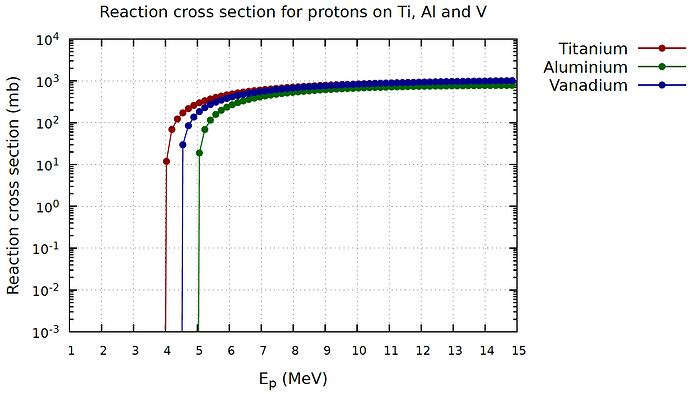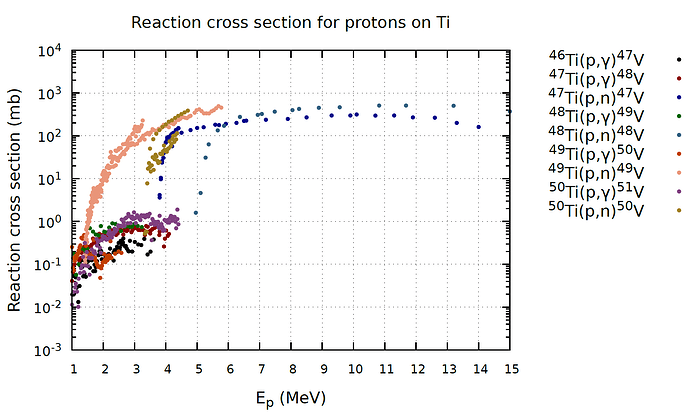Dear Jatinder,
Thank you for your questions, welcome to the forum, and sorry for the slight delay.
the 3 MeV simulations are not even producing results, but just giving a dose rate of 0.
The parametrization employed in FLUKA for proton reaction cross sections has a threshold effect (loosely intending to account for Coulomb barrier effects), typically in the order of a few MeV. However, this threshold is at times a bit too high, and it may well block otherwise open low-energy nuclear reaction channels at lower energies, normally (p,n) and (p,γ).
The following plot shows the FLUKA reaction cross section parametrization for protons on Ti, Al, and V (the constituents of your Ti6Al4V compound). At 3 MeV the FLUKA proton reaction cross section vanishes and this explains why you do not score any ambient dose rates:
Note, however, that this is an artefact of the FLUKA reaction cross section parametrization. As you can see in the following plot with experimental data from EXFOR, for various isotopes of Ti there are open channels at 3 MeV, indeed (p,γ) and (p,n):
In previous versions of the code, local fixes to remedy this artefact were done on an isotope-by-isotope basis. See, e.g. Low energy Cu(p,x) cross section - #3 by cesc. This aspect may be revisited in future versions of the code.
Are there limits to how small the geometries can be?
Yes, but in your case, the problem is not the geometry and its dimensions, but rather the low energy of the incident proton beam (3 MeV), falling a bit below the spurious threshold in the FLUKA proton reaction cross section parametrization, as outlined above.
Are my simulations set up correctly for the relatively “low” proton energies? Or is there something that I am missing? As the dose rate results for the 15MeV are a factor of 10000 out at 60s cooling compared to other simulations considering the same irradiation settings
For this observation, could you provide any reference you used in your comparison of the dose rates? Upon a first look at your input, all employed conversion factors look alright (both in the input and in the Flair plot tab).
I have some additional remarks regarding your input files:
-
You may want to revisit your COMPOUND card. If you express the composition in terms of the atom content, you are indicating the stoichiometry, i.e. you need to indicate the number of atoms of each element. In your case that would rather be: 6 atoms of Ti, 4 atoms of Al, and 1 atom of V. For more details, you can consult the following material:
https://indico.cern.ch/event/1012211/contributions/4247792/attachments/2256347/3828711/06_Materials_2021_online.pdf. -
In the MAT-PROP card with SDUM = DPA-ENER, the default values of b_arcdpa and c_arcdpa are both 0, which means that you are not scoring ARC-DPA, but DPA-NRT, as per Note 7 in: 7.22.44. MAT-PROP — FLUKA Manual
-
One comment regarding the following statement:
with proton beams (…) with a current of 30 uA (1.875x10^14 p/cm^2/s)
The beam intensity that you indicate in WHAT(2) of the IRRPROFI card is expressed in particles/s. Your conversion was alright, except that there are no units of cm^(-2).
-
It may be wise not to set the beam starting position exactly on the boundary between two regions as you do now (between the black hole and the void).
Cheers,
Alexandra

